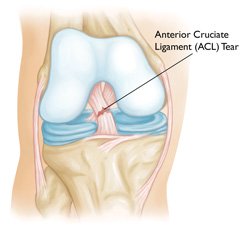ACL Tears: Not Just For Athletes
With so many high-profile, professional athletes overcoming ACL tears, it’s becoming well-known that this is one of the most common sports-related injuries. However, what may be less understood is that ACL tears don’t just affect professional or competitive athletes.
Understanding ACL Tears
The anterior cruciate ligament (ACL) is one of four ligaments that helps ensure stability in the knee and proper movement. The main causes of an ACL tear include:
- Pivoting or changing direction quickly
- Making a sudden stop
- Landing from a jump incorrectly
For these reasons, it makes sense that football, basketball and soccer are sports that see this injury a lot. But when you think about everyday life, many activities also involve these movements:
- Running after and playing with your kids
- Trying a new cardio-fitness class
- Jumping on a trampoline
Plus, as we age, changes in the ACL, previous knee injuries and reduced strength can also increase the risk for a tear from something as simple as stepping in a hole.
For a professional or competitive athlete, the loud pop, sudden instability and immediate swelling of an ACL tear could be a season-ending injury. But what does it mean for a moderately active adult?
Sandy’s Story
Sandy Fragale has been the administrator at Orthopedic & Sports Medicine Specialists of Green Bay (OSMS) for 15 years, so she is familiar with ACL tears. However, when she was at a trampoline park in November 2015 with family and friends, her ACL was the last thing on her mind.
Until, she suddenly went down.
“As soon as I landed and fell, I knew I injured something,” she says. “It felt like my skin tore.”
Sandy needed help to get off the trampoline, but she walked out to the car by herself. The next day, she saw an orthopedic physician at OSMS. During her exam, as the doctor was easily able to push her knee back and forth, it was pretty clear that Sandy had torn her ACL. And an MRI confirmed it.
The next step – deciding if surgery was the best treatment option.
“Surgical reconstruction is determined by a number of factors, including a patient’s past, current and desired activity level,” says Dr. Thomas Sullivan, an orthopedic surgeon at OSMS. “With an ACL tear, surgery doesn’t have to happen immediately, so patients can schedule it to fit into their lives. In fact, we won’t perform the surgery until all the swelling has disappeared, which typically takes a couple weeks.”
While Sandy is no longer a competitive athlete, she is still a very active person. That’s one reason why she chose to have surgery.
“I didn’t want to be limited long-term in the activities I could do, like skiing or playing beach volleyball on vacation,” Sandy says. “And I knew not fixing it could lead to an earlier development of arthritis.”
Since Sandy’s initial injury happened right around Thanksgiving, she decided to wait and have her surgery in January to avoid taking time off of work during the busy end-of-year or missing out on holiday fun with her family.
Sandy’s post-surgery results:
- Within three days, she was off pain medications.
- Her leg was immediately weight-bearing.
- She went back to work in just one week.
- Now, eight-weeks post-surgery, she has no pain, full range of motion in her knee and is able to use the elliptical, treadmill, bike and lift weights.
Read Part 2 to learn about the important role pre and postoperative physical therapy played in Sandy’s recovery.







